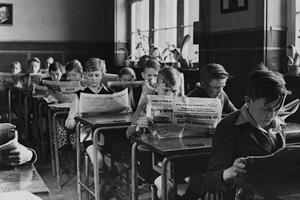Bohemian borders
Historian Tara Zahra writes that in early 20th-century Europe, nationalism meant fighting over children.
By Laura Putre
Photo credit: Corbis
In 1998, when historian Tara Zahra was about to embark on her University of Michigan PhD, she went to Vienna to get a head start on her dissertation. She was interested in Czech and German nationalist schools in the early 20th century, when the Austrian Empire was in disarray. The Bohemian territory in Eastern and Central Europe had been ruled by the Habsburg monarchs for 400 years. Czech-speaking people historically dwelled there alongside Germans or invading German armies. But as the empire crumbled, the question of where national boundaries would fall and who would rule the land was up for grabs.

German students read the Völkischer Beobachter, a National Socialist paper started in the 1920s, in part to incite anti-Czech sentiment.
Nationalist groups from both sides claimed to be establishing schools to preserve their respective languages and traditions. But their primary intent, Zahra found, was not to create opportunities for learning language and culture, but to coerce people who were otherwise disinterested in nationality to choose allegiances.
In a region where ethnic boundaries had been blurred for centuries, few citizens identified fiercely with one ethnicity or another, Zahra found. Czechs had German friends, Austrian children summered with Czech families, religions crisscrossed ethnic lines, and languages and marriages intermingled. “In reality you had this massive number of children and parents who really belonged neither to the Czech nor German nation,” says Zahra, who since 2006 has been a history-department assistant professor of East European studies.
The fight over children’s nationalities, and the need to categorize people on both sides, not only became Zahra’s dissertation, but it also grew into a book released last year: Kidnapped Souls: National Indifference and the Battle for Children in the Bohemian Lands, 1900–1948 (Cornell University Press). The time period she chose was particularly transitional, with four different government regimes in the Bohemian lands in 50 years: the Habsburg monarchy; Czechoslovakia; the Nazi Protectorate of Bohemia and Moravia/Sudetenland; and, after World War II, the Czechoslovak state minus its forced-out German residents.
After the Austrian Empire collapsed in 1918, Czech and German nationalists predicted that without the “neutral umpire,” as Zahra calls it, of the Habsburg monarchy, people would align themselves with one ethnicity or another. But instead, nationalists found a populace comfortable with being bilingual and multicultural.
Increasingly, nationalist groups had to either entice people to join their rolls with perks and benefits—including free textbooks, lunch, clothing, and Christmas gifts for children attending nationalist schools—or bring them around forcibly. Beginning in 1921, Czech citizens were required to signify nationality on the census. If the government suspected someone had chosen the “wrong” nationality (say, they stated “German” but their children attended Czech-language schools) they faced interrogation, fines, and imprisonment. “There were all sorts of people who said they were German, but the government said, ‘No, you’re not—we think you’re really Czech,” says Zahra. “And then there would be a court case about it, and a panel of judges would have to decide, ‘Is this child Czech or German?’”
Beefing up their ranks gave nationalists military strength, whether real or perceived, as well as legitimacy for their cause, says Zahra. Healthy population numbers lent might in an era when birth rates were declining and death rates rising because of all the war and conflict in the region, not to mention the influenza epidemic of 1918. As a result, nationalists obsessively tracked how many children were enrolled in their schools, how many people counted Czech or German as their primary language in the census, and how many children were “lost” to the nation by death or allegedly being co-opted by the other side.
While researching Kidnapped Souls, Zahra was surprised to find that after World War I, the number of children the Nazis kidnapped for “Germanization” was much smaller than Czech nationalists had claimed. That finding planted the seed for a forthcoming book, Lost Children: Displaced Families and the Reconstruction of Europe (Harvard University Press), which she’s still writing. It describes how a shift in international policy toward displaced children between the world wars—from meeting basic needs in World War I to reunifying families in World War II—paved the way for the rebuilding and reshaping of Europe.
As for her own ethnic roots, the Pennsylvania-bred Zahra claims allegiance only to the Poconos and describes her family as “nationally indifferent.” One paternal grandparent was a Sephardic Jew from Turkey. Her surname is Maltese, Zahra says, but the grandfather who passed it down was adopted. Zahra’s interest in the region’s history stems instead from her undergraduate years at Swarthmore, where she studied with Pieter Judson, a Habsburg-monarchy scholar.
The lack of familial ties to the region works to her advantage, she says, especially because her scholarship questions ethnic and national boundaries. “Up until recently, people have tended to write about Eastern Europe in terms of nations, like the history of the Czech nation,” she says. “It’s only recently that people have started to question the extent people identify with those categories.”